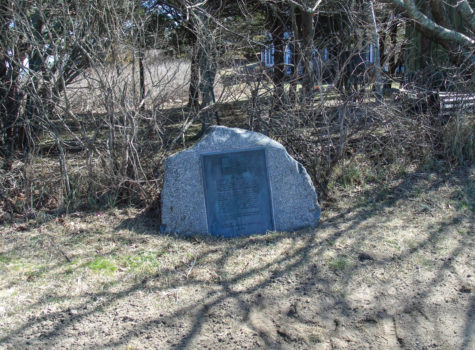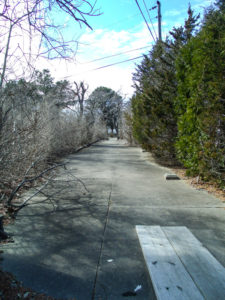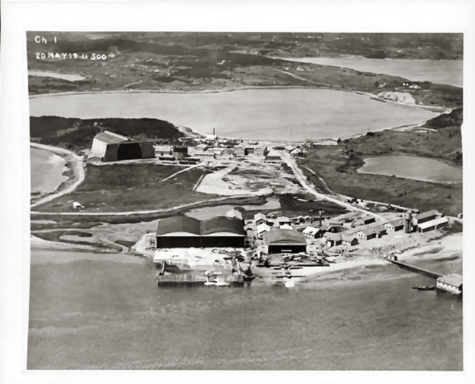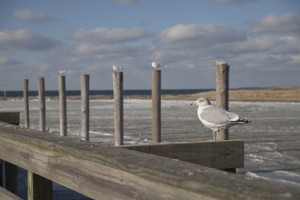
The Marker for the Chatham Naval Air Station located on Strong Island Road. Photo courtesy of Christopher Setterlund.
A century ago Cape Cod was a far different place than it is today to say the least. Automobiles were scarce. In fact the first paved roads would not arrive until after World War I. According to the 1910 census the population of the entire Cape was only 27,542, or roughly 17,000 less than the population of Barnstable alone today. It was a simpler time without malls, highways, television, or internet.
In the town of Chatham, in the village known as Chatham Port, there came and went an important piece of American Military history. It was only a blip on the radar in the story of Cape Cod, and reminders of it are extremely difficult to find today. However in its short time it managed to carve out a vital legacy. It was the Chatham Naval Air Station and this is only the tip of the iceberg of its story.
By 1917 World War I had been raging in Europe for three years. The Central Powers of Germany, Austria-Hungary and the Ottoman Empire were battling with the Allied Powers of Great Britain, France, Russia, Italy and Japan. The United States joined the Allies in April 1917. After joining the war effort a naval air station was commissioned by the government to be constructed in Chatham as it was one of the eastern most points in the United States.

A section of a concrete foundation once part of the Naval Air Station. Photo courtesy of Christopher Setterlund.
The air station would be built at Nickerson Neck, the area best known today as the location of the Eastward Ho Country Club. Laborers would be paid $4.50 per day to construct the machine shops, barracks, storage houses, and mess halls, not to mention the landing areas for airplanes and dirigibles. There was also a gigantic hangar where the dirigibles were housed. Measuring 252-feet long, 125-feet wide, and 75-feet tall it was an impressive structure. Throughout the winter of 1917-1918 the naval station would be constructed on thirty-six acres. The station would be manned and ready for duty in the spring of 1918, at its peak it would be home to 600 enlisted men. It would not take long for it to see action.
On July 21, 1918, only a few months after opening aircraft at the naval air station were called upon. A few miles north in Orleans World War I had reached the shores of the United States. A German SM-156 U-Boat had opened fire upon a tugboat and four barges. The boats were evacuated and shells would sink three of the four barges. Some shells missed their targets and would crash into Nauset Beach making it the only time that enemy fire struck American soil in the war. Two planes were scrambled from the Chatham Naval Air Station and would drop two bombs on the U-Boat; unfortunately both of them were defective and did not explode. The action was enough however to scare off the Germans.

The Blimp Hangar at the Chatham Naval Air Station is courtesy of the Atwood House Museum in Chatham.
Nearly a year later another monumental moment happened at the Naval Air Station. On May 9, 1919 a plane would land at the station for refueling. This was a Curtiss NC-4 ‘flying boat’ flown by Lieutenant Commander Albert Cushing Read. He had taken off the previous day from Rockaway, New York on Long Island trying to be the first aircraft to cross the Atlantic Ocean. The aircraft, with its four engines, three in the front and one in the back, was crewed by five including Read. After refueling the NC-4 would continue on its journey and after some shaky moments landed in Plymouth, England on May 31st. Eight years later Charles Lindbergh would complete the first solo nonstop flight across the Atlantic in May 1927.
With the war over the Naval Air Station became expendable. In May 1920 the station was preparing to be closed. 160 men were transferred to other bases while ten were left behind to guard the property. In 1922 Washington D.C. labeled the Chatham Naval Air Station as inoperative, effectively ending its tenure in service. The Naval Department would purchase the base the following year and in 1924 the process of removing the structures on the property began. Some of the lumber from buildings would become parts of new homes; some even went to repair damage at the famed Chequesset Inn in Wellfleet in 1928. The dirigible hangar was removed in 1933 and by 1938 the base had been completely dismantled save for the concrete foundations strewn across the thirty-six acres.

Chatham Naval Station 1920 – This aerial view of the naval base in its prime is courtesy of the National Archives at Boston.
In the decades after the area of Nickerson Neck would become the location of many high-end homes. When constructing these homes many owners took the time to have the concrete foundations torn up and removed. However, not all of the concrete has been removed. Today there are still visible remnants of the former naval station scattered around Nickerson Neck. When walking, or driving, the side roads in the area one can spot old walls and foundations. It is a connection to a place that was a bright flash and then was gone. The only marker commemorating the base sits at the end of Strong Island Road and includes an engraved image of the Curtiss NC-4 ‘flying boat.’ Those who are not aware of the history of the Chatham Naval Air Station may not realize what once stood there.
By Christopher Setterlund
























